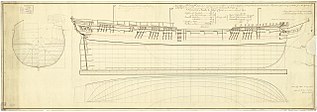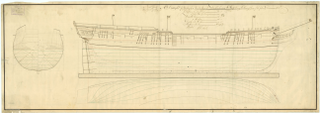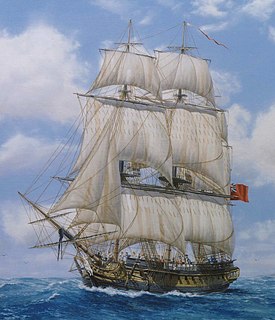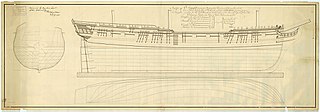
HMS Galatea was a fifth-rate 32-gun sailing frigate of the British Royal Navy that George Parsons built at Bursledon and launched in 1794. Before she was broken up in 1809 she captured numerous prizes and participated in a number of actions, first in the Channel and off Ireland (1794–1803), and then in the Caribbean (1802–1809), including one that earned her crew the Naval General Service Medal.

HMS Indefatigable was one of the Ardent-class 64-gun third-rate ships-of-the-line designed by Sir Thomas Slade in 1761 for the Royal Navy. She was built as a ship-of-the-line, but most of her active service took place after her conversion to a 44-gun razee frigate. She had a long career under several distinguished commanders, serving throughout the French Revolutionary Wars and the Napoleonic Wars. She took some 27 prizes, alone or in company, and the Admiralty authorised the issue of four clasps to the Naval General Service Medal in 1847 to any surviving members of her crews from the respective actions. She was broken up in 1816.

HMS Naiad was a Royal Navy fifth-rate frigate that served in the Napoleonic Wars. She was built by Hall and Co. at Limehouse on the Thames, launched in 1797, and commissioned in 1798. She served in the French Revolutionary and Napoleonic Wars, and her last actions occurred in 1824–5. She was paid off in 1826. She then served for many years in Latin America as a coal depot, first for the Royal Navy and then for the Pacific Steam Navigation Company. She was broken up in 1898, 101 years after her launching.
HMS Boadicea was a frigate of the Royal Navy. She served in the Channel and in the East Indies during which service she captured many prizes. She participated in one action for which the Admiralty awarded the Naval General Service Medal. She was broken up in 1858.

HMS Dryad was a fifth-rate sailing frigate of the Royal Navy that served for 64 years, at first during the Napoleonic Wars and then in the suppression of slavery. She fought in a notable single-ship action in 1805 when she captured the French frigate Proserpine, an action that would later earn her crew the Naval General Service Medal. Dryad was broken up at Portsmouth in 1860.

HMS Cerberus was a 32-gun fifth-rate frigate of the Royal Navy. She served in the French Revolutionary and the Napoleonic Wars in the Channel, the Mediterranean, the Adriatic, and even briefly in the Baltic against the Russians. She participated in one boat action that won for her crew a clasp to the Naval General Service Medal (NGSM). She also captured many privateers and merchant vessels. Her biggest battle was the Battle of Lissa, which won for her crew another clasp to the NGSM. She was sold in 1814.

HMS Melampus was a Royal Navy fifth-rate frigate that served during the French Revolutionary and Napoleonic Wars. She captured numerous prizes before the British sold her to the Royal Netherlands Navy in 1815. With the Dutch, she participated in a major action at Algiers and, then, in a number of colonial punitive expeditions in the Dutch East Indies.

HMS Amethyst was a Royal Navy 36-gun Penelope-class fifth-rate frigate, launched in 1799 at Deptford. Amethyst served in the French Revolutionary Wars and the Napoleonic Wars, capturing several prizes. She also participated in two boat actions and two ship actions that won her crew clasps to the Naval General Service Medal. She was broken up in 1811 after suffering severe damage in a storm.

HMS Unicorn was a 32-gun fifth-rate Pallas-class frigate of the Royal Navy, launched in 1794 at Chatham. This frigate served in both the French Revolutionary Wars and the Napoleonic Wars, including a medal action early in her career. She was broken up in 1815.
HMS Atalante was a 16-gun brig-sloop of the Royal Navy. She was formerly the French Atalante, captured in 1797. She served with the British during the French Revolutionary and Napoleonic Wars, and was wrecked in 1807.
During the French Revolutionary and Napoleonic Wars the Admiralty also made use of hired armed vessels, one of which was His Majesty's Hired armed cutter Swan. Actually there were two such cutters, but the descriptions of these vessels and the dates of their service are such that they may well represent one vessel under successive contracts. The vessel or vessels cruised, blockaded, carried despatches and performed reconnaissance.

HMS Cruizer was a Royal Navy Cruizer-class brig-sloop built by Stephen Teague of Ipswich and launched in 1797. She was the first ship of the class, but there was a gap of 5 years between her launch and the ordering of the next batch in October 1803; by 1815 a total of 105 other vessels had been ordered to her design. She had an eventful wartime career, mostly in the North Sea, English Channel and the Baltic, and captured some 15 privateers and warships, and many merchant vessels. She also participated in several actions. She was laid up in 1813 and the Commissioners of the Navy sold her for breaking in 1819.

His Majesty's hired armed cutter Telemachus served the Royal Navy from 17 June 1795 until 15 January 1801. She was of 1285⁄95 tons (bm), and carried fourteen 4-pounder guns. During her five and a half years of service to the Royal Navy she captured eight French privateers as well as many merchant vessels.

HMS Sprightly was a 10-gun cutter of the Royal Navy, built to a design by John Williams, and the name ship of her two-vessel class of cutters. She was launched in 1778. The French captured and scuttled her off the Andulasian coast in 1801.

HMS Greyhound was a cutter that the British Admiralty purchased in 1780 and renamed Viper in 1781. Viper captured several French privateers in the waters around Great Britain, and took part in a notable engagement. She was sold in October 1809.

HMS Clyde was a Royal Navy Artois-class frigate built at Chatham Dockyard of fir, and launched in 1796. In 1797, she was one of only two ships whose captains were able to maintain some control over their vessels during the Nore mutiny. In 1805, HMS Clyde was dismantled and rebuilt at Woolwich Dockyard; she was relaunched on 23 February 1806. She was ultimately sold in August 1814.

HMS Childers was a brig-sloop of the British Royal Navy, initially armed with 10 carriage guns which were later increased to 14 guns. The first brig-sloop to be built for the Navy, she was ordered from a commercial builder during the early years of the American War of Independence, and went on to support operations in the English Channel and the Caribbean. Laid up for a time after the end of the American War of Independence, she returned to service shortly before the outbreak of the French Revolutionary Wars. She had an active career in both the French Revolutionary and Napoleonic Wars, capturing numerous French privateers and during the Gunboat War participated in a noteworthy single-ship action. The navy withdrew her from service at the beginning of 1811, at which time she was broken up.

HMS Skylark was a British Royal Navy 16-gun brig-sloop of the Seagull class launched in February 1806. She served primarily in the Channel, capturing several vessels including a privateer, and taking part in one notable engagement. She grounded in May 1812 and her crew burnt her to prevent the French from capturing her.

The French brig Suffisante was launched in 1793 for the French Navy. In 1795 the Royal Navy captured her and took her into service under her existing name. HMS Suffisante captured seven privateers during her career, as well as recapturing some British merchantmen and capturing a number of prizes, some of them valuable. She was lost in December 1803 when she grounded in poor weather in Cork harbour.
Éole was an 18-gun corvette of the French Navy, launched, captured, and later commissioned in the Royal Navy in 1799 as HMS Nimrod after her capture by HMS Solebay. She was then "the finest and most handsome ship-sloop in the British navy". She was sold in 1811. Nimrod made three whaling voyages between 1811 and 1819. On her first she captured several American whalers. Nimrod was last listed in 1820.